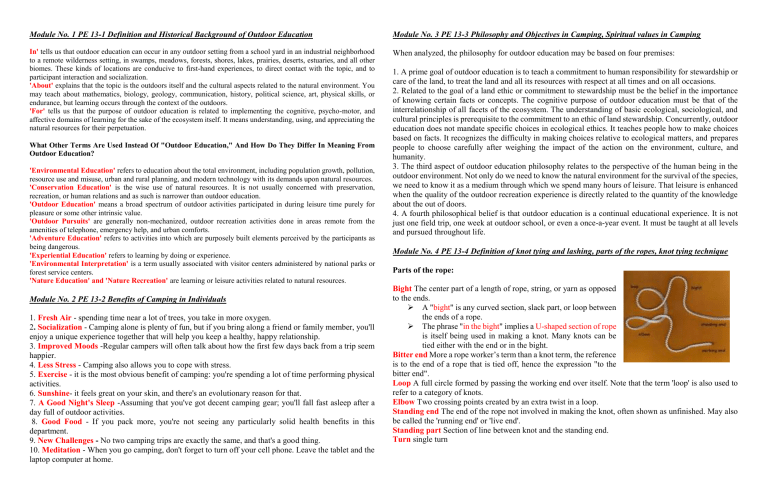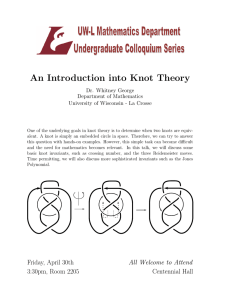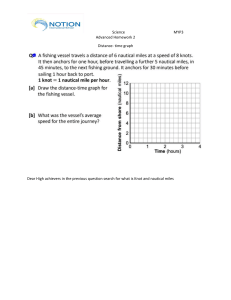Outdoor Education, Camping, Knots, Sign Language Module
advertisement

Module No. 1 PE 13-1 Definition and Historical Background of Outdoor Education Module No. 3 PE 13-3 Philosophy and Objectives in Camping, Spiritual values in Camping In' tells us that outdoor education can occur in any outdoor setting from a school yard in an industrial neighborhood to a remote wilderness setting, in swamps, meadows, forests, shores, lakes, prairies, deserts, estuaries, and all other biomes. These kinds of locations are conducive to first-hand experiences, to direct contact with the topic, and to participant interaction and socialization. 'About' explains that the topic is the outdoors itself and the cultural aspects related to the natural environment. You may teach about mathematics, biology, geology, communication, history, political science, art, physical skills, or endurance, but learning occurs through the context of the outdoors. 'For' tells us that the purpose of outdoor education is related to implementing the cognitive, psycho-motor, and affective domains of learning for the sake of the ecosystem itself. It means understanding, using, and appreciating the natural resources for their perpetuation. When analyzed, the philosophy for outdoor education may be based on four premises: What Other Terms Are Used Instead Of "Outdoor Education," And How Do They Differ In Meaning From Outdoor Education? 'Environmental Education' refers to education about the total environment, including population growth, pollution, resource use and misuse, urban and rural planning, and modern technology with its demands upon natural resources. 'Conservation Education' is the wise use of natural resources. It is not usually concerned with preservation, recreation, or human relations and as such is narrower than outdoor education. 'Outdoor Education' means a broad spectrum of outdoor activities participated in during leisure time purely for pleasure or some other intrinsic value. 'Outdoor Pursuits' are generally non-mechanized, outdoor recreation activities done in areas remote from the amenities of telephone, emergency help, and urban comforts. 'Adventure Education' refers to activities into which are purposely built elements perceived by the participants as being dangerous. 'Experiential Education' refers to learning by doing or experience. 'Environmental Interpretation' is a term usually associated with visitor centers administered by national parks or forest service centers. 'Nature Education' and 'Nature Recreation' are learning or leisure activities related to natural resources. Module No. 2 PE 13-2 Benefits of Camping in Individuals 1. Fresh Air - spending time near a lot of trees, you take in more oxygen. 2. Socialization - Camping alone is plenty of fun, but if you bring along a friend or family member, you'll enjoy a unique experience together that will help you keep a healthy, happy relationship. 3. Improved Moods -Regular campers will often talk about how the first few days back from a trip seem happier. 4. Less Stress - Camping also allows you to cope with stress. 5. Exercise - it is the most obvious benefit of camping: you're spending a lot of time performing physical activities. 6. Sunshine- it feels great on your skin, and there's an evolutionary reason for that. 7. A Good Night's Sleep -Assuming that you've got decent camping gear; you'll fall fast asleep after a day full of outdoor activities. 8. Good Food - If you pack more, you're not seeing any particularly solid health benefits in this department. 9. New Challenges - No two camping trips are exactly the same, and that's a good thing. 10. Meditation - When you go camping, don't forget to turn off your cell phone. Leave the tablet and the laptop computer at home. 1. A prime goal of outdoor education is to teach a commitment to human responsibility for stewardship or care of the land, to treat the land and all its resources with respect at all times and on all occasions. 2. Related to the goal of a land ethic or commitment to stewardship must be the belief in the importance of knowing certain facts or concepts. The cognitive purpose of outdoor education must be that of the interrelationship of all facets of the ecosystem. The understanding of basic ecological, sociological, and cultural principles is prerequisite to the commitment to an ethic of land stewardship. Concurrently, outdoor education does not mandate specific choices in ecological ethics. It teaches people how to make choices based on facts. It recognizes the difficulty in making choices relative to ecological matters, and prepares people to choose carefully after weighing the impact of the action on the environment, culture, and humanity. 3. The third aspect of outdoor education philosophy relates to the perspective of the human being in the outdoor environment. Not only do we need to know the natural environment for the survival of the species, we need to know it as a medium through which we spend many hours of leisure. That leisure is enhanced when the quality of the outdoor recreation experience is directly related to the quantity of the knowledge about the out of doors. 4. A fourth philosophical belief is that outdoor education is a continual educational experience. It is not just one field trip, one week at outdoor school, or even a once-a-year event. It must be taught at all levels and pursued throughout life. Module No. 4 PE 13-4 Definition of knot tying and lashing, parts of the ropes, knot tying technique Parts of the rope: Bight The center part of a length of rope, string, or yarn as opposed to the ends. A "bight" is any curved section, slack part, or loop between the ends of a rope. The phrase "in the bight" implies a U-shaped section of rope is itself being used in making a knot. Many knots can be tied either with the end or in the bight. Bitter end More a rope worker’s term than a knot term, the reference is to the end of a rope that is tied off, hence the expression "to the bitter end". Loop A full circle formed by passing the working end over itself. Note that the term 'loop' is also used to refer to a category of knots. Elbow Two crossing points created by an extra twist in a loop. Standing end The end of the rope not involved in making the knot, often shown as unfinished. May also be called the 'running end' or 'live end'. Standing part Section of line between knot and the standing end. Turn single turn KNOT TYING - It is the oldest form of combining two things/ object with the use of knot. 1. 2. 3. Overhand Knot it is the easiest and practical knot. Square Knot is quick and easy to tie; it is a good knot for securing non-critical items. Figure Eight Knot the figure eight follow through is one of the strongest knots. It forms a secure, non-slip loop at the end of a rope. Also known as the Flemish Bend, this is the most widely used tiein knot by mountain climbers. 4. Fisherman’s knot also known as English knot, consists of two overhand knots each one tied around the standing part of the other one. 5. Timber Hitch Knot use for securing a rope around a post or any cylindrical object. 6. Clove Hitch a simple all-purpose hitch. Easy to tie and untie. A useful and easy to tie knot, the Clove Hitch is a good binding knot. 7. Two half hitches can be used to tie a rope to a tree, boat or any object. It is often used in a supporting role, for example to increase the security of a primary knot. 8. Slip Knot this version of a slip knot is very quick and easy to tie. It is technically a “slip noose” and is made using the fisherman’s knot. 9. Bowline Knot one of the most useful knots you can know. The Bowline forms a secure loop that will not jam and is easy to tie and untie. 10. Sheepshank unreliable knot used to shorten a length of rope temporarily. Skills in Sign Language Communication of thoughts or ideas by means of manual signs and gestures, esp. between two people who have no language in common. A language used as by the deaf, consisting of a system of signs and gestures Module No. 5 PE-13 -5 Definition of Sign Language and Skills in Sign Language Definition and Brief History of Sign Language Sign languages (also known as signed languages) are languages that use the visual manual modality to convey meaning. Sign languages are expressed through manual articulations in combination with nonmanual elements. Sign languages are full-fledged natural languages with their own grammar and lexicon. Sign languages are not universal and they are not mutually intelligible with each other, although there are also striking similarities among sign languages. Linguists distinguish natural sign languages from other systems that are precursors to them or derived from them, such as invented manual codes for spoken languages, home sign, "baby sign", and signs learned by non-human primates. Why is outdoor education important for Deaf and hard of hearing individuals? For some time now, there has always been this existing barrier facing Deaf and hard of hearing participants in outdoor education and recreation settings. The barriers are typically economic, educational, social, risk management, legal and accessibility. aims to reduce barriers for the Deaf and hard of hearing community by providing affordable and accessible outdoor education. There are so many benefits to experiencing outdoor education, experiential education, and outdoor recreation


